Comparative Analysis: Wood and Concrete in International Construction
VerifiedAdded on 2023/06/04
|29
|7909
|416
Report
AI Summary
This report provides a comprehensive comparison of wood and concrete as international construction materials. It begins with background information on both materials, highlighting wood's environmental benefits and positive psychological effects, while acknowledging concrete's potential for environmental pollution. The report then explores the reasons behind material selection in specific countries, such as Australia's preference for wood due to availability and climate, and India's use of concrete due to material availability and climatic considerations. The report delves into the positive and negative aspects of both wood and concrete construction, covering aspects like time-saving, aesthetics, thermal properties, durability, and strength for wood, and availability, strength, and fire safety for concrete. It also discusses common construction techniques like prefabrication and building information modeling, and their adoption in Australia and India. The report further examines how these techniques impact the environment and international construction, concluding with a comparative analysis to determine better techniques for sustainable development.
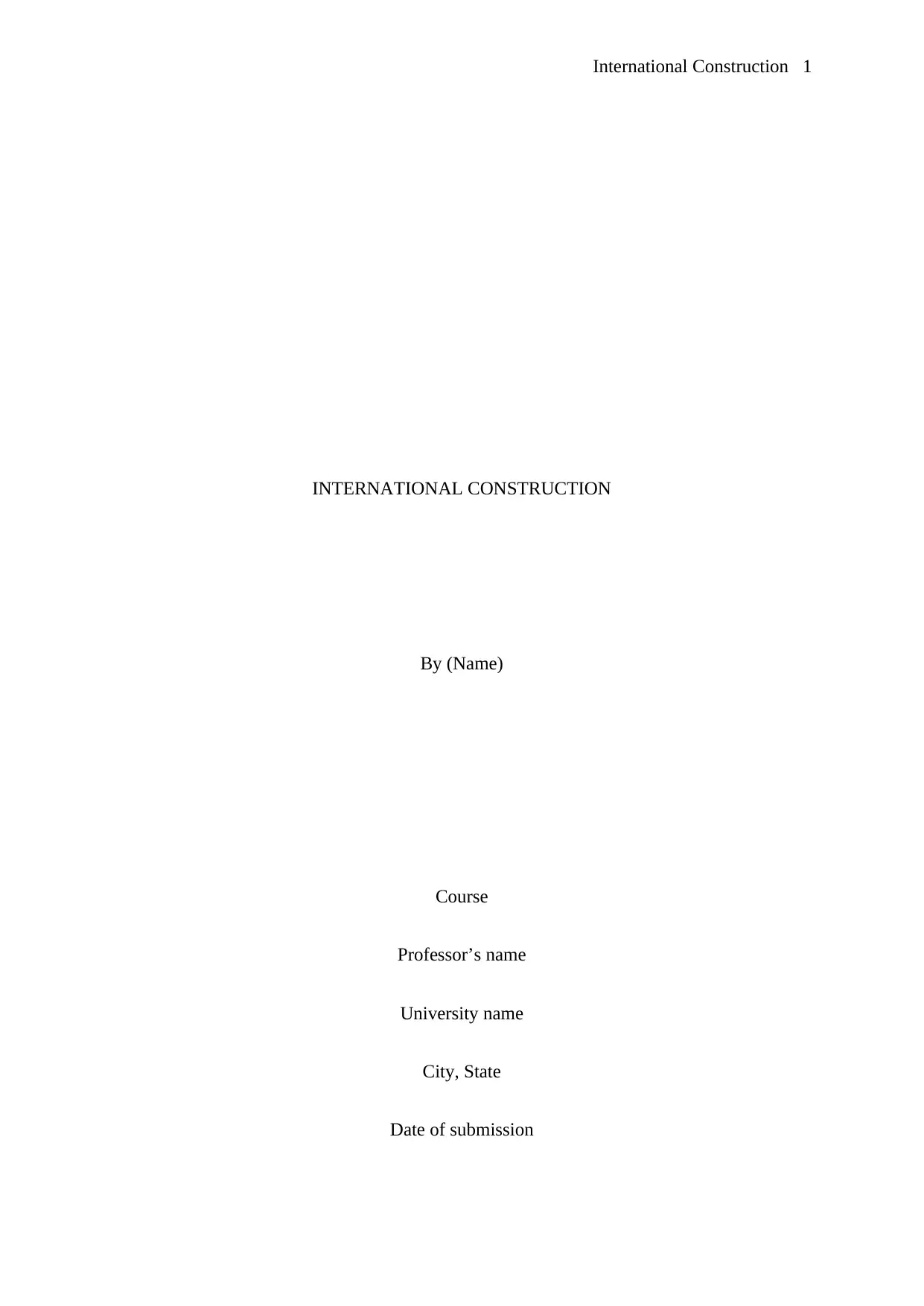
International Construction 1
INTERNATIONAL CONSTRUCTION
By (Name)
Course
Professor’s name
University name
City, State
Date of submission
INTERNATIONAL CONSTRUCTION
By (Name)
Course
Professor’s name
University name
City, State
Date of submission
Paraphrase This Document
Need a fresh take? Get an instant paraphrase of this document with our AI Paraphraser
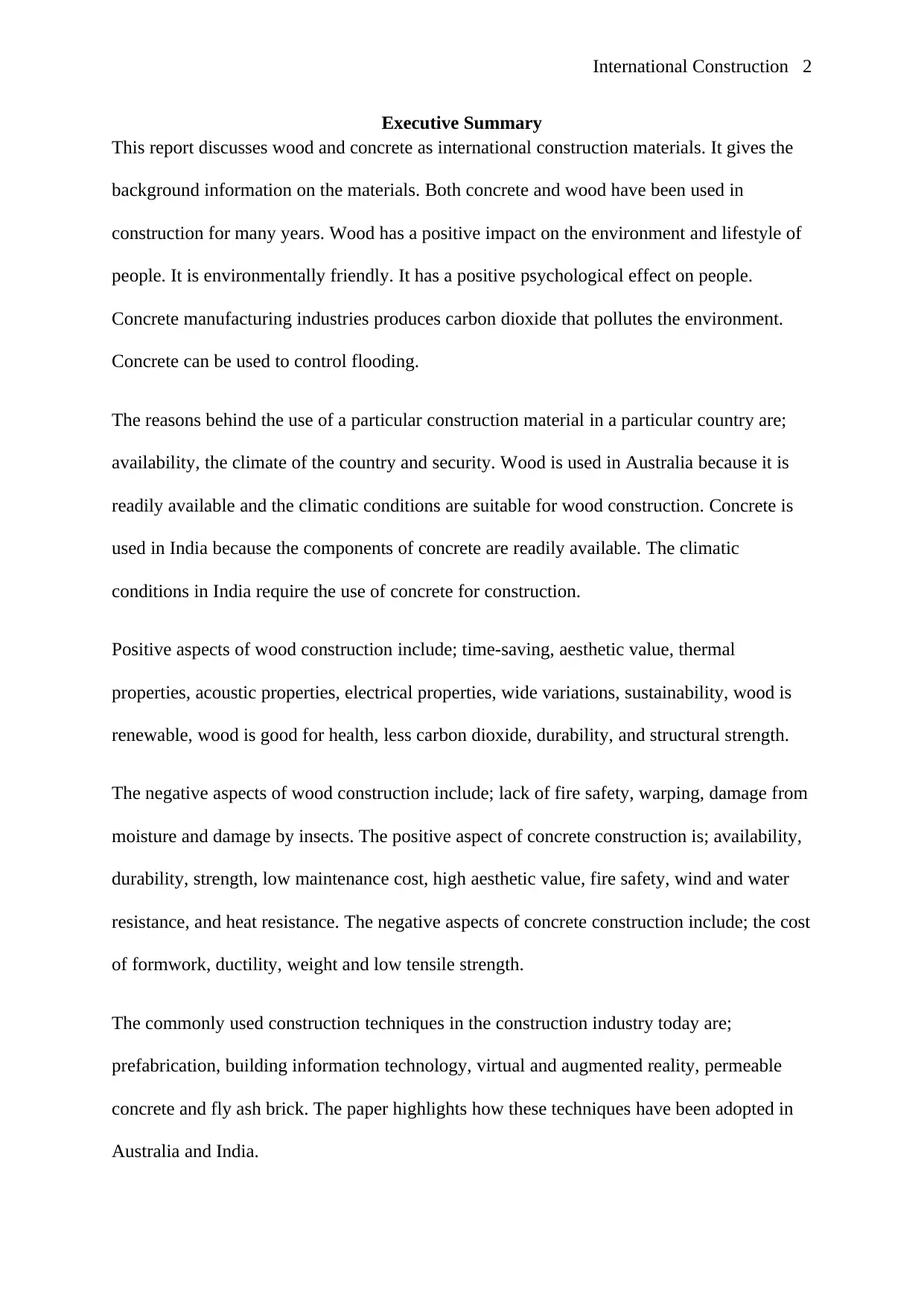
International Construction 2
Executive Summary
This report discusses wood and concrete as international construction materials. It gives the
background information on the materials. Both concrete and wood have been used in
construction for many years. Wood has a positive impact on the environment and lifestyle of
people. It is environmentally friendly. It has a positive psychological effect on people.
Concrete manufacturing industries produces carbon dioxide that pollutes the environment.
Concrete can be used to control flooding.
The reasons behind the use of a particular construction material in a particular country are;
availability, the climate of the country and security. Wood is used in Australia because it is
readily available and the climatic conditions are suitable for wood construction. Concrete is
used in India because the components of concrete are readily available. The climatic
conditions in India require the use of concrete for construction.
Positive aspects of wood construction include; time-saving, aesthetic value, thermal
properties, acoustic properties, electrical properties, wide variations, sustainability, wood is
renewable, wood is good for health, less carbon dioxide, durability, and structural strength.
The negative aspects of wood construction include; lack of fire safety, warping, damage from
moisture and damage by insects. The positive aspect of concrete construction is; availability,
durability, strength, low maintenance cost, high aesthetic value, fire safety, wind and water
resistance, and heat resistance. The negative aspects of concrete construction include; the cost
of formwork, ductility, weight and low tensile strength.
The commonly used construction techniques in the construction industry today are;
prefabrication, building information technology, virtual and augmented reality, permeable
concrete and fly ash brick. The paper highlights how these techniques have been adopted in
Australia and India.
Executive Summary
This report discusses wood and concrete as international construction materials. It gives the
background information on the materials. Both concrete and wood have been used in
construction for many years. Wood has a positive impact on the environment and lifestyle of
people. It is environmentally friendly. It has a positive psychological effect on people.
Concrete manufacturing industries produces carbon dioxide that pollutes the environment.
Concrete can be used to control flooding.
The reasons behind the use of a particular construction material in a particular country are;
availability, the climate of the country and security. Wood is used in Australia because it is
readily available and the climatic conditions are suitable for wood construction. Concrete is
used in India because the components of concrete are readily available. The climatic
conditions in India require the use of concrete for construction.
Positive aspects of wood construction include; time-saving, aesthetic value, thermal
properties, acoustic properties, electrical properties, wide variations, sustainability, wood is
renewable, wood is good for health, less carbon dioxide, durability, and structural strength.
The negative aspects of wood construction include; lack of fire safety, warping, damage from
moisture and damage by insects. The positive aspect of concrete construction is; availability,
durability, strength, low maintenance cost, high aesthetic value, fire safety, wind and water
resistance, and heat resistance. The negative aspects of concrete construction include; the cost
of formwork, ductility, weight and low tensile strength.
The commonly used construction techniques in the construction industry today are;
prefabrication, building information technology, virtual and augmented reality, permeable
concrete and fly ash brick. The paper highlights how these techniques have been adopted in
Australia and India.
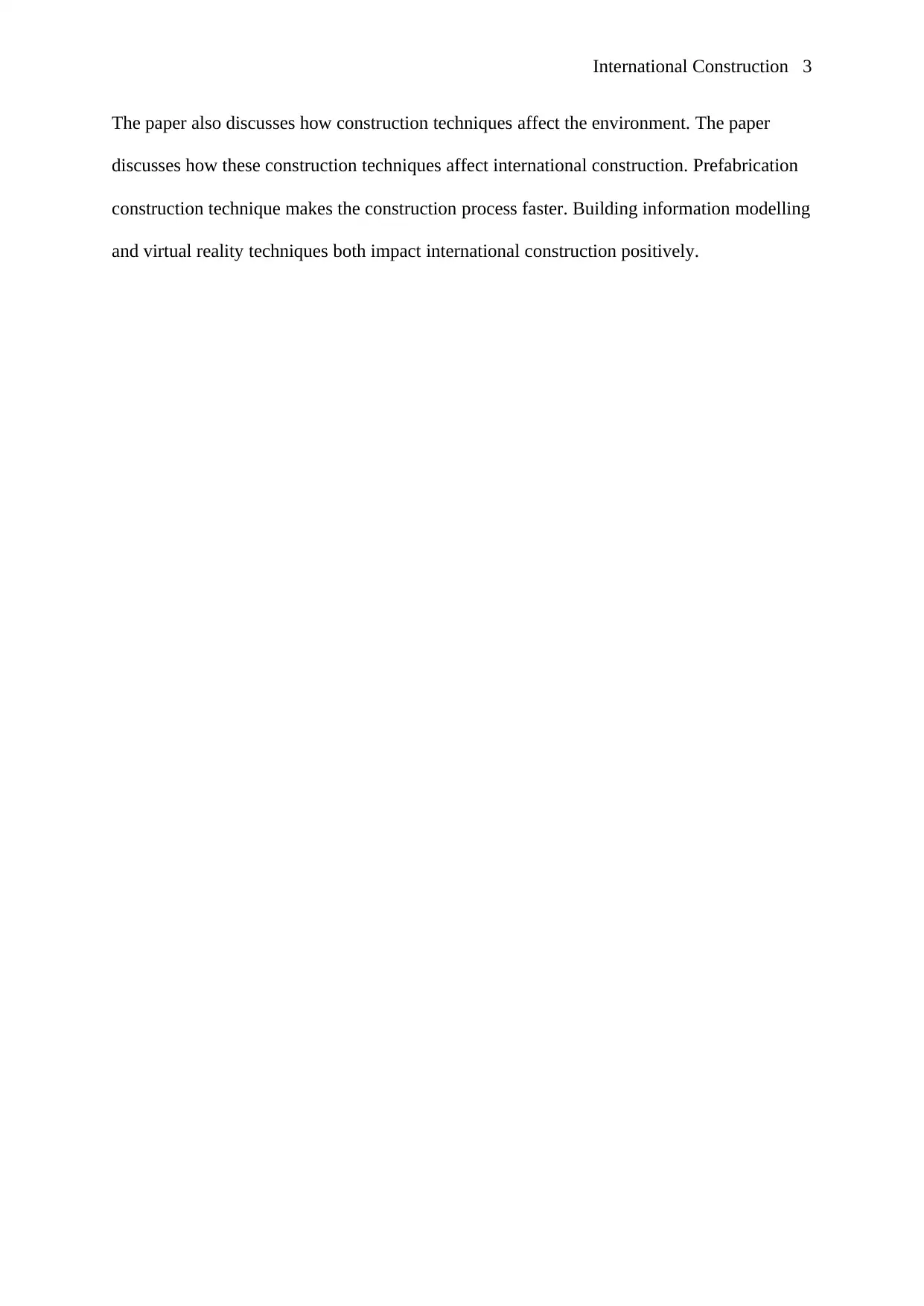
International Construction 3
The paper also discusses how construction techniques affect the environment. The paper
discusses how these construction techniques affect international construction. Prefabrication
construction technique makes the construction process faster. Building information modelling
and virtual reality techniques both impact international construction positively.
The paper also discusses how construction techniques affect the environment. The paper
discusses how these construction techniques affect international construction. Prefabrication
construction technique makes the construction process faster. Building information modelling
and virtual reality techniques both impact international construction positively.
⊘ This is a preview!⊘
Do you want full access?
Subscribe today to unlock all pages.

Trusted by 1+ million students worldwide
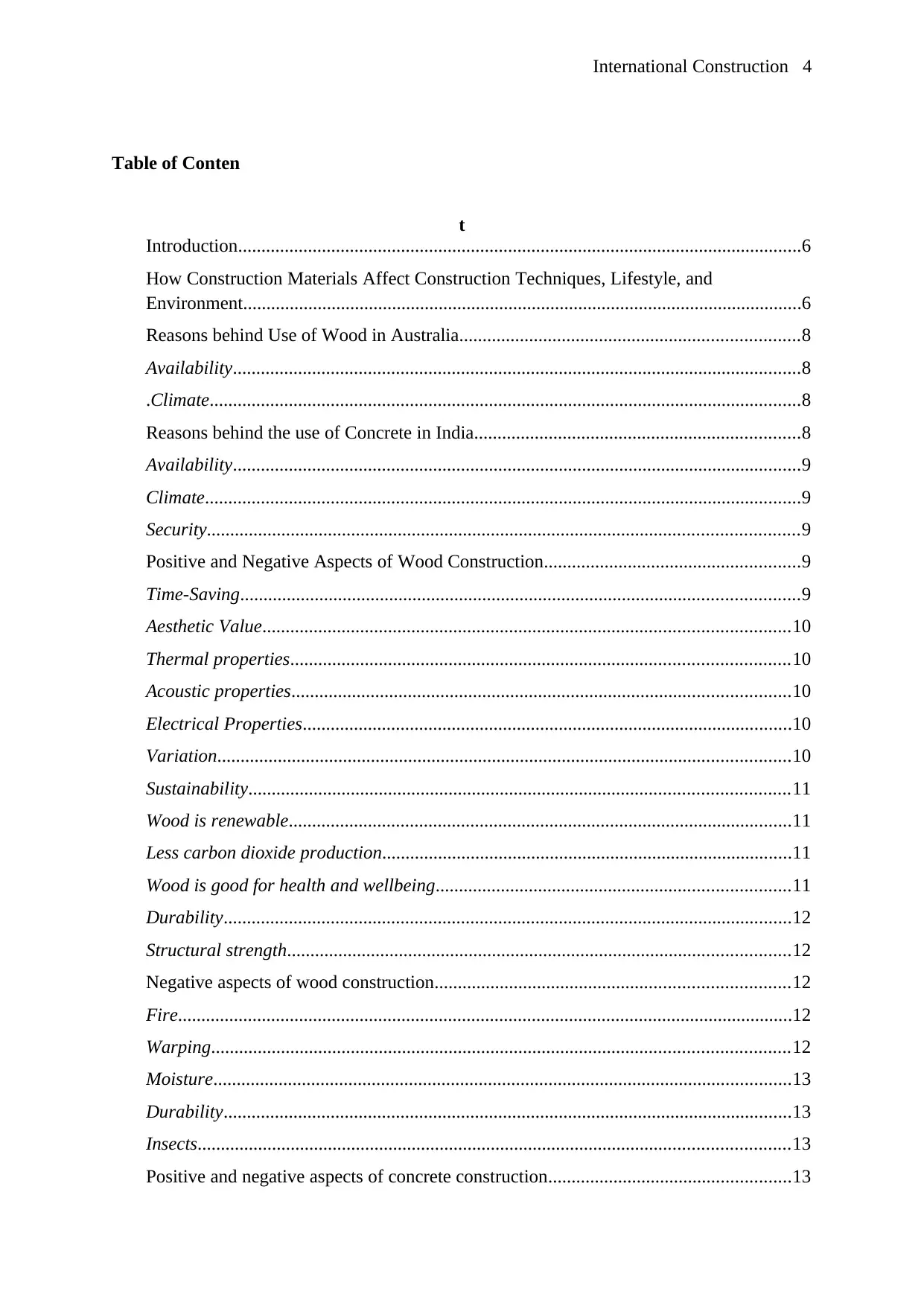
International Construction 4
Table of Conten
t
Introduction.........................................................................................................................6
How Construction Materials Affect Construction Techniques, Lifestyle, and
Environment........................................................................................................................6
Reasons behind Use of Wood in Australia.........................................................................8
Availability..........................................................................................................................8
.Climate...............................................................................................................................8
Reasons behind the use of Concrete in India......................................................................8
Availability..........................................................................................................................9
Climate................................................................................................................................9
Security...............................................................................................................................9
Positive and Negative Aspects of Wood Construction.......................................................9
Time-Saving........................................................................................................................9
Aesthetic Value.................................................................................................................10
Thermal properties...........................................................................................................10
Acoustic properties...........................................................................................................10
Electrical Properties.........................................................................................................10
Variation...........................................................................................................................10
Sustainability....................................................................................................................11
Wood is renewable............................................................................................................11
Less carbon dioxide production........................................................................................11
Wood is good for health and wellbeing............................................................................11
Durability..........................................................................................................................12
Structural strength............................................................................................................12
Negative aspects of wood construction............................................................................12
Fire....................................................................................................................................12
Warping............................................................................................................................12
Moisture............................................................................................................................13
Durability..........................................................................................................................13
Insects...............................................................................................................................13
Positive and negative aspects of concrete construction....................................................13
Table of Conten
t
Introduction.........................................................................................................................6
How Construction Materials Affect Construction Techniques, Lifestyle, and
Environment........................................................................................................................6
Reasons behind Use of Wood in Australia.........................................................................8
Availability..........................................................................................................................8
.Climate...............................................................................................................................8
Reasons behind the use of Concrete in India......................................................................8
Availability..........................................................................................................................9
Climate................................................................................................................................9
Security...............................................................................................................................9
Positive and Negative Aspects of Wood Construction.......................................................9
Time-Saving........................................................................................................................9
Aesthetic Value.................................................................................................................10
Thermal properties...........................................................................................................10
Acoustic properties...........................................................................................................10
Electrical Properties.........................................................................................................10
Variation...........................................................................................................................10
Sustainability....................................................................................................................11
Wood is renewable............................................................................................................11
Less carbon dioxide production........................................................................................11
Wood is good for health and wellbeing............................................................................11
Durability..........................................................................................................................12
Structural strength............................................................................................................12
Negative aspects of wood construction............................................................................12
Fire....................................................................................................................................12
Warping............................................................................................................................12
Moisture............................................................................................................................13
Durability..........................................................................................................................13
Insects...............................................................................................................................13
Positive and negative aspects of concrete construction....................................................13
Paraphrase This Document
Need a fresh take? Get an instant paraphrase of this document with our AI Paraphraser
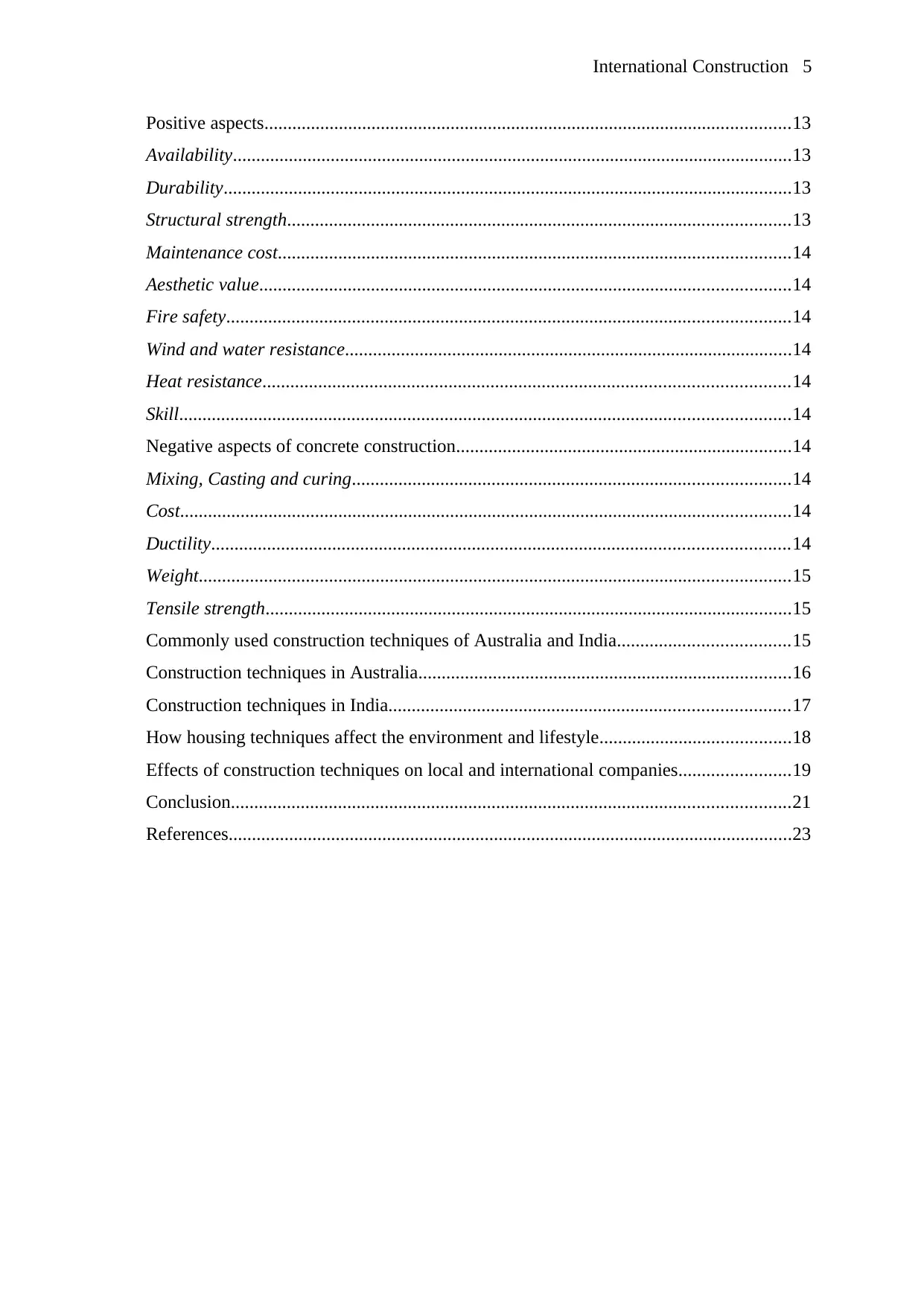
International Construction 5
Positive aspects.................................................................................................................13
Availability........................................................................................................................13
Durability..........................................................................................................................13
Structural strength............................................................................................................13
Maintenance cost..............................................................................................................14
Aesthetic value..................................................................................................................14
Fire safety.........................................................................................................................14
Wind and water resistance................................................................................................14
Heat resistance.................................................................................................................14
Skill...................................................................................................................................14
Negative aspects of concrete construction........................................................................14
Mixing, Casting and curing..............................................................................................14
Cost...................................................................................................................................14
Ductility............................................................................................................................14
Weight...............................................................................................................................15
Tensile strength.................................................................................................................15
Commonly used construction techniques of Australia and India.....................................15
Construction techniques in Australia................................................................................16
Construction techniques in India......................................................................................17
How housing techniques affect the environment and lifestyle.........................................18
Effects of construction techniques on local and international companies........................19
Conclusion........................................................................................................................21
References.........................................................................................................................23
Positive aspects.................................................................................................................13
Availability........................................................................................................................13
Durability..........................................................................................................................13
Structural strength............................................................................................................13
Maintenance cost..............................................................................................................14
Aesthetic value..................................................................................................................14
Fire safety.........................................................................................................................14
Wind and water resistance................................................................................................14
Heat resistance.................................................................................................................14
Skill...................................................................................................................................14
Negative aspects of concrete construction........................................................................14
Mixing, Casting and curing..............................................................................................14
Cost...................................................................................................................................14
Ductility............................................................................................................................14
Weight...............................................................................................................................15
Tensile strength.................................................................................................................15
Commonly used construction techniques of Australia and India.....................................15
Construction techniques in Australia................................................................................16
Construction techniques in India......................................................................................17
How housing techniques affect the environment and lifestyle.........................................18
Effects of construction techniques on local and international companies........................19
Conclusion........................................................................................................................21
References.........................................................................................................................23
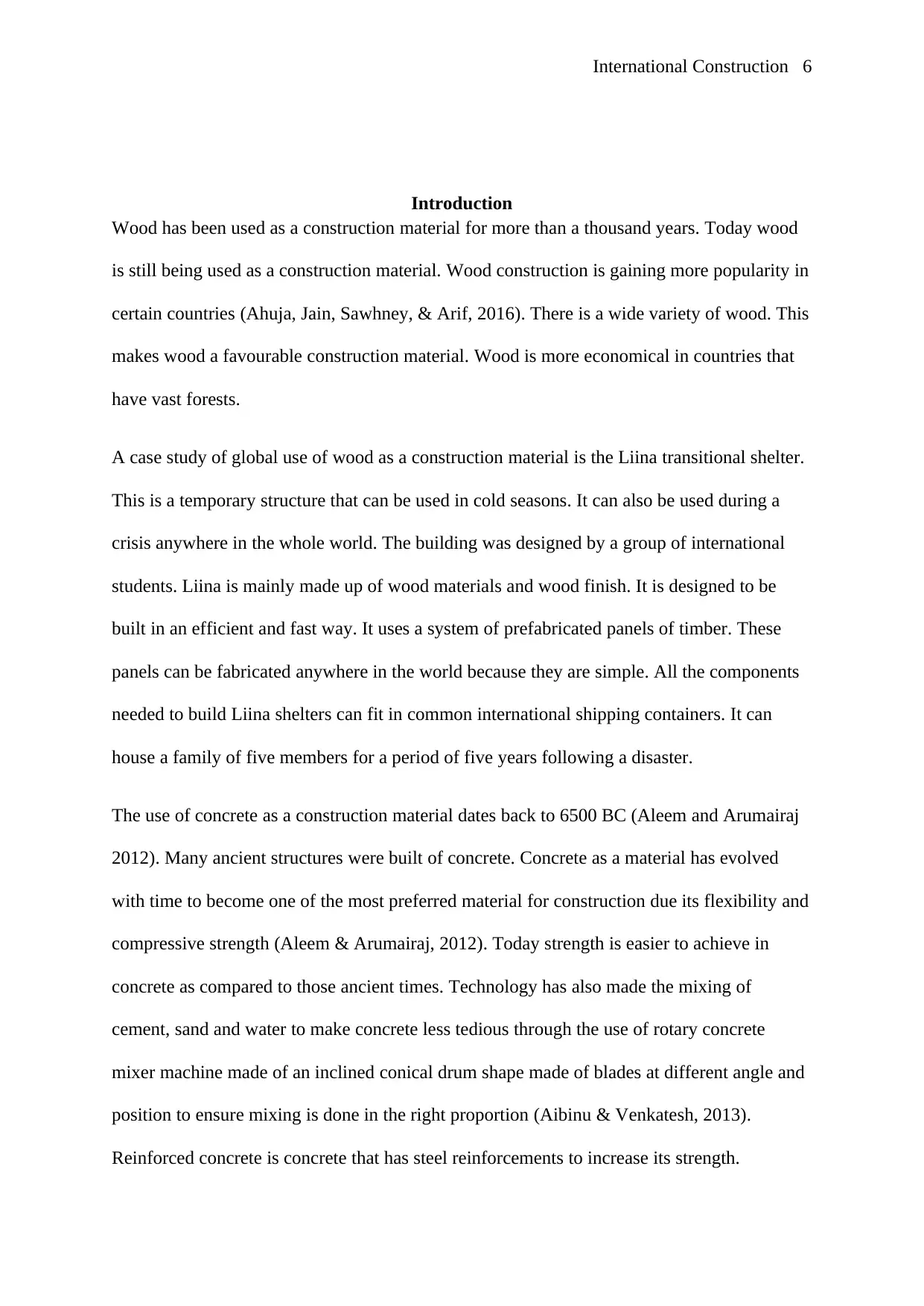
International Construction 6
Introduction
Wood has been used as a construction material for more than a thousand years. Today wood
is still being used as a construction material. Wood construction is gaining more popularity in
certain countries (Ahuja, Jain, Sawhney, & Arif, 2016). There is a wide variety of wood. This
makes wood a favourable construction material. Wood is more economical in countries that
have vast forests.
A case study of global use of wood as a construction material is the Liina transitional shelter.
This is a temporary structure that can be used in cold seasons. It can also be used during a
crisis anywhere in the whole world. The building was designed by a group of international
students. Liina is mainly made up of wood materials and wood finish. It is designed to be
built in an efficient and fast way. It uses a system of prefabricated panels of timber. These
panels can be fabricated anywhere in the world because they are simple. All the components
needed to build Liina shelters can fit in common international shipping containers. It can
house a family of five members for a period of five years following a disaster.
The use of concrete as a construction material dates back to 6500 BC (Aleem and Arumairaj
2012). Many ancient structures were built of concrete. Concrete as a material has evolved
with time to become one of the most preferred material for construction due its flexibility and
compressive strength (Aleem & Arumairaj, 2012). Today strength is easier to achieve in
concrete as compared to those ancient times. Technology has also made the mixing of
cement, sand and water to make concrete less tedious through the use of rotary concrete
mixer machine made of an inclined conical drum shape made of blades at different angle and
position to ensure mixing is done in the right proportion (Aibinu & Venkatesh, 2013).
Reinforced concrete is concrete that has steel reinforcements to increase its strength.
Introduction
Wood has been used as a construction material for more than a thousand years. Today wood
is still being used as a construction material. Wood construction is gaining more popularity in
certain countries (Ahuja, Jain, Sawhney, & Arif, 2016). There is a wide variety of wood. This
makes wood a favourable construction material. Wood is more economical in countries that
have vast forests.
A case study of global use of wood as a construction material is the Liina transitional shelter.
This is a temporary structure that can be used in cold seasons. It can also be used during a
crisis anywhere in the whole world. The building was designed by a group of international
students. Liina is mainly made up of wood materials and wood finish. It is designed to be
built in an efficient and fast way. It uses a system of prefabricated panels of timber. These
panels can be fabricated anywhere in the world because they are simple. All the components
needed to build Liina shelters can fit in common international shipping containers. It can
house a family of five members for a period of five years following a disaster.
The use of concrete as a construction material dates back to 6500 BC (Aleem and Arumairaj
2012). Many ancient structures were built of concrete. Concrete as a material has evolved
with time to become one of the most preferred material for construction due its flexibility and
compressive strength (Aleem & Arumairaj, 2012). Today strength is easier to achieve in
concrete as compared to those ancient times. Technology has also made the mixing of
cement, sand and water to make concrete less tedious through the use of rotary concrete
mixer machine made of an inclined conical drum shape made of blades at different angle and
position to ensure mixing is done in the right proportion (Aibinu & Venkatesh, 2013).
Reinforced concrete is concrete that has steel reinforcements to increase its strength.
⊘ This is a preview!⊘
Do you want full access?
Subscribe today to unlock all pages.

Trusted by 1+ million students worldwide
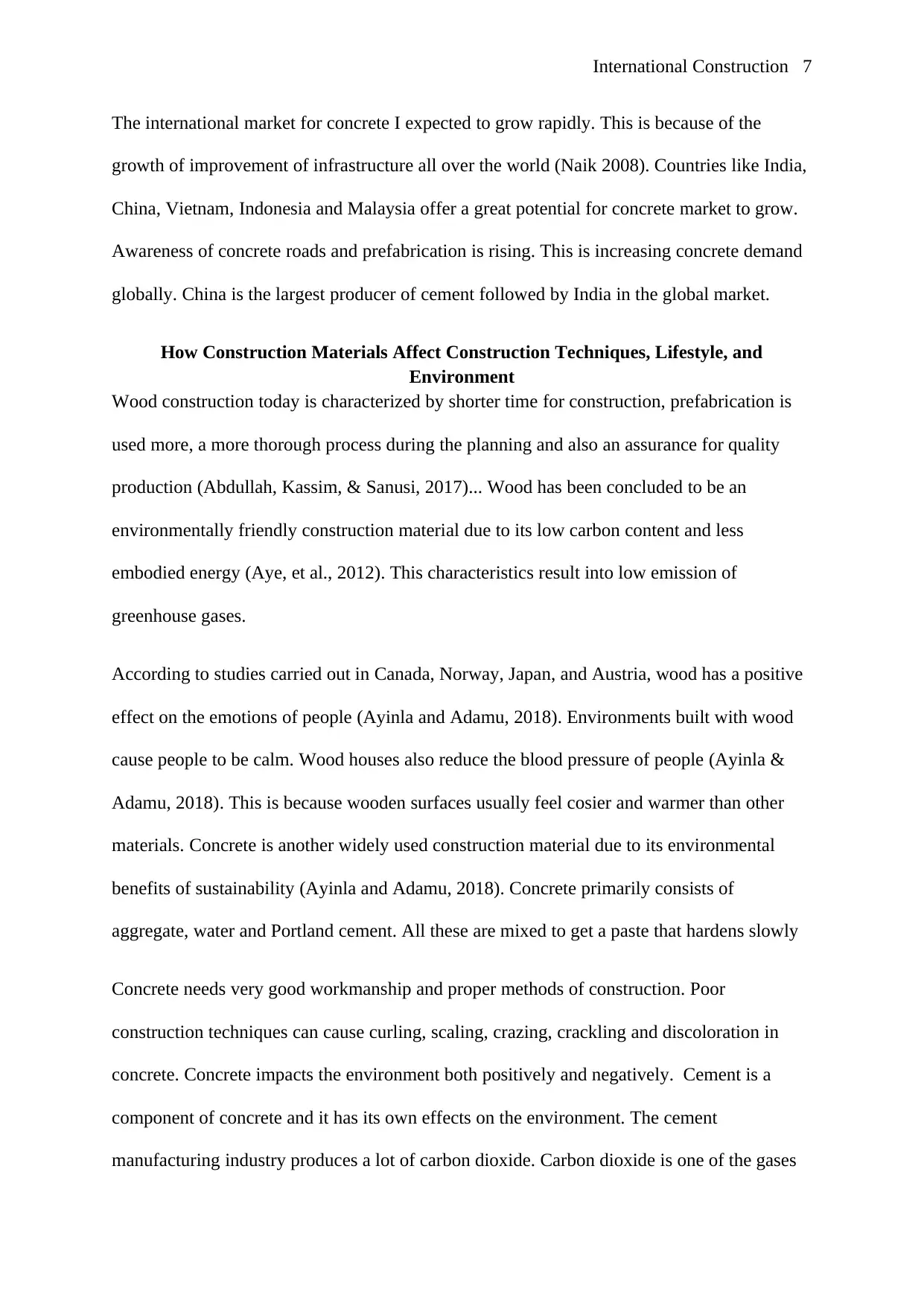
International Construction 7
The international market for concrete I expected to grow rapidly. This is because of the
growth of improvement of infrastructure all over the world (Naik 2008). Countries like India,
China, Vietnam, Indonesia and Malaysia offer a great potential for concrete market to grow.
Awareness of concrete roads and prefabrication is rising. This is increasing concrete demand
globally. China is the largest producer of cement followed by India in the global market.
How Construction Materials Affect Construction Techniques, Lifestyle, and
Environment
Wood construction today is characterized by shorter time for construction, prefabrication is
used more, a more thorough process during the planning and also an assurance for quality
production (Abdullah, Kassim, & Sanusi, 2017)... Wood has been concluded to be an
environmentally friendly construction material due to its low carbon content and less
embodied energy (Aye, et al., 2012). This characteristics result into low emission of
greenhouse gases.
According to studies carried out in Canada, Norway, Japan, and Austria, wood has a positive
effect on the emotions of people (Ayinla and Adamu, 2018). Environments built with wood
cause people to be calm. Wood houses also reduce the blood pressure of people (Ayinla &
Adamu, 2018). This is because wooden surfaces usually feel cosier and warmer than other
materials. Concrete is another widely used construction material due to its environmental
benefits of sustainability (Ayinla and Adamu, 2018). Concrete primarily consists of
aggregate, water and Portland cement. All these are mixed to get a paste that hardens slowly
Concrete needs very good workmanship and proper methods of construction. Poor
construction techniques can cause curling, scaling, crazing, crackling and discoloration in
concrete. Concrete impacts the environment both positively and negatively. Cement is a
component of concrete and it has its own effects on the environment. The cement
manufacturing industry produces a lot of carbon dioxide. Carbon dioxide is one of the gases
The international market for concrete I expected to grow rapidly. This is because of the
growth of improvement of infrastructure all over the world (Naik 2008). Countries like India,
China, Vietnam, Indonesia and Malaysia offer a great potential for concrete market to grow.
Awareness of concrete roads and prefabrication is rising. This is increasing concrete demand
globally. China is the largest producer of cement followed by India in the global market.
How Construction Materials Affect Construction Techniques, Lifestyle, and
Environment
Wood construction today is characterized by shorter time for construction, prefabrication is
used more, a more thorough process during the planning and also an assurance for quality
production (Abdullah, Kassim, & Sanusi, 2017)... Wood has been concluded to be an
environmentally friendly construction material due to its low carbon content and less
embodied energy (Aye, et al., 2012). This characteristics result into low emission of
greenhouse gases.
According to studies carried out in Canada, Norway, Japan, and Austria, wood has a positive
effect on the emotions of people (Ayinla and Adamu, 2018). Environments built with wood
cause people to be calm. Wood houses also reduce the blood pressure of people (Ayinla &
Adamu, 2018). This is because wooden surfaces usually feel cosier and warmer than other
materials. Concrete is another widely used construction material due to its environmental
benefits of sustainability (Ayinla and Adamu, 2018). Concrete primarily consists of
aggregate, water and Portland cement. All these are mixed to get a paste that hardens slowly
Concrete needs very good workmanship and proper methods of construction. Poor
construction techniques can cause curling, scaling, crazing, crackling and discoloration in
concrete. Concrete impacts the environment both positively and negatively. Cement is a
component of concrete and it has its own effects on the environment. The cement
manufacturing industry produces a lot of carbon dioxide. Carbon dioxide is one of the gases
Paraphrase This Document
Need a fresh take? Get an instant paraphrase of this document with our AI Paraphraser
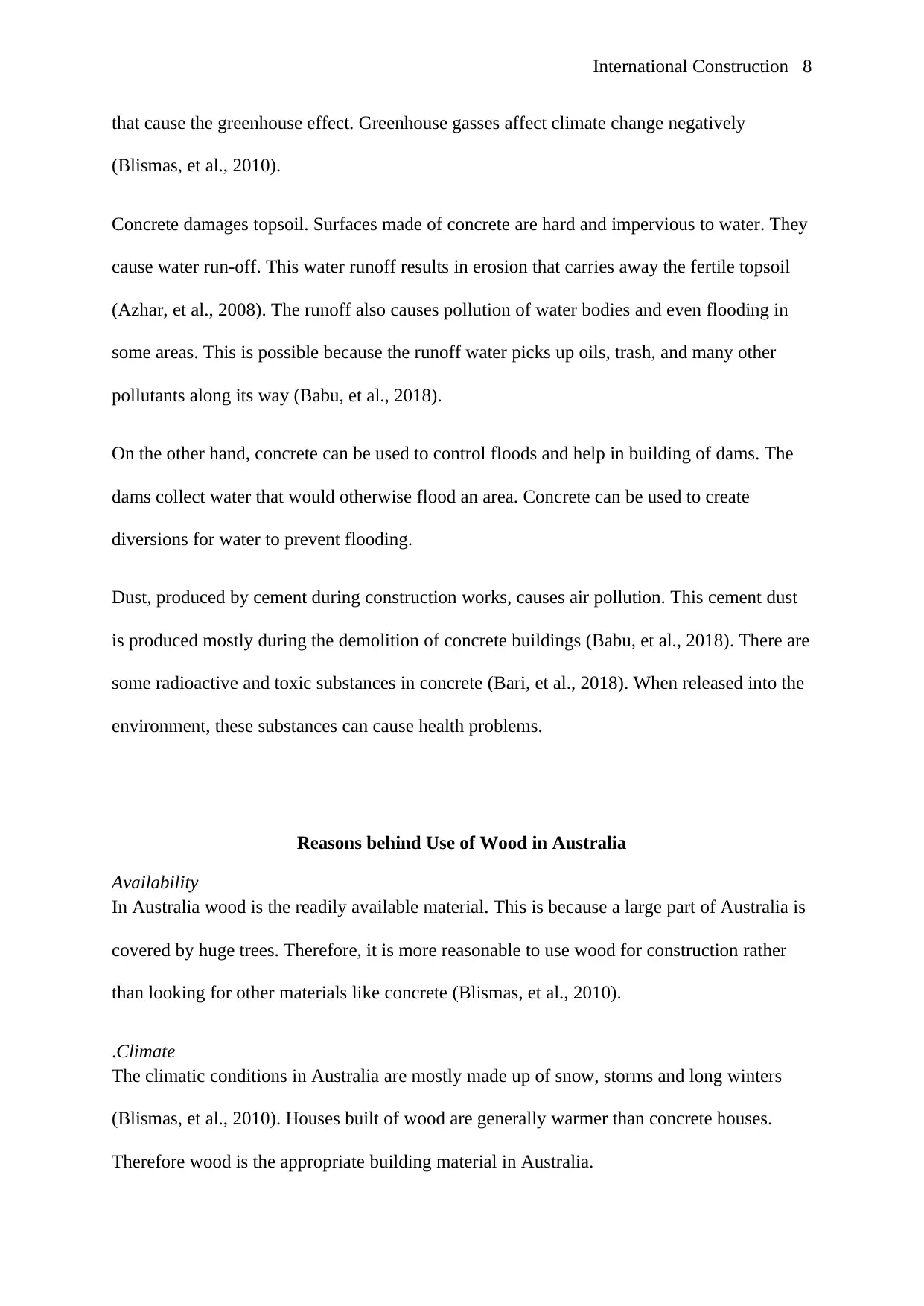
International Construction 8
that cause the greenhouse effect. Greenhouse gasses affect climate change negatively
(Blismas, et al., 2010).
Concrete damages topsoil. Surfaces made of concrete are hard and impervious to water. They
cause water run-off. This water runoff results in erosion that carries away the fertile topsoil
(Azhar, et al., 2008). The runoff also causes pollution of water bodies and even flooding in
some areas. This is possible because the runoff water picks up oils, trash, and many other
pollutants along its way (Babu, et al., 2018).
On the other hand, concrete can be used to control floods and help in building of dams. The
dams collect water that would otherwise flood an area. Concrete can be used to create
diversions for water to prevent flooding.
Dust, produced by cement during construction works, causes air pollution. This cement dust
is produced mostly during the demolition of concrete buildings (Babu, et al., 2018). There are
some radioactive and toxic substances in concrete (Bari, et al., 2018). When released into the
environment, these substances can cause health problems.
Reasons behind Use of Wood in Australia
Availability
In Australia wood is the readily available material. This is because a large part of Australia is
covered by huge trees. Therefore, it is more reasonable to use wood for construction rather
than looking for other materials like concrete (Blismas, et al., 2010).
.Climate
The climatic conditions in Australia are mostly made up of snow, storms and long winters
(Blismas, et al., 2010). Houses built of wood are generally warmer than concrete houses.
Therefore wood is the appropriate building material in Australia.
that cause the greenhouse effect. Greenhouse gasses affect climate change negatively
(Blismas, et al., 2010).
Concrete damages topsoil. Surfaces made of concrete are hard and impervious to water. They
cause water run-off. This water runoff results in erosion that carries away the fertile topsoil
(Azhar, et al., 2008). The runoff also causes pollution of water bodies and even flooding in
some areas. This is possible because the runoff water picks up oils, trash, and many other
pollutants along its way (Babu, et al., 2018).
On the other hand, concrete can be used to control floods and help in building of dams. The
dams collect water that would otherwise flood an area. Concrete can be used to create
diversions for water to prevent flooding.
Dust, produced by cement during construction works, causes air pollution. This cement dust
is produced mostly during the demolition of concrete buildings (Babu, et al., 2018). There are
some radioactive and toxic substances in concrete (Bari, et al., 2018). When released into the
environment, these substances can cause health problems.
Reasons behind Use of Wood in Australia
Availability
In Australia wood is the readily available material. This is because a large part of Australia is
covered by huge trees. Therefore, it is more reasonable to use wood for construction rather
than looking for other materials like concrete (Blismas, et al., 2010).
.Climate
The climatic conditions in Australia are mostly made up of snow, storms and long winters
(Blismas, et al., 2010). Houses built of wood are generally warmer than concrete houses.
Therefore wood is the appropriate building material in Australia.
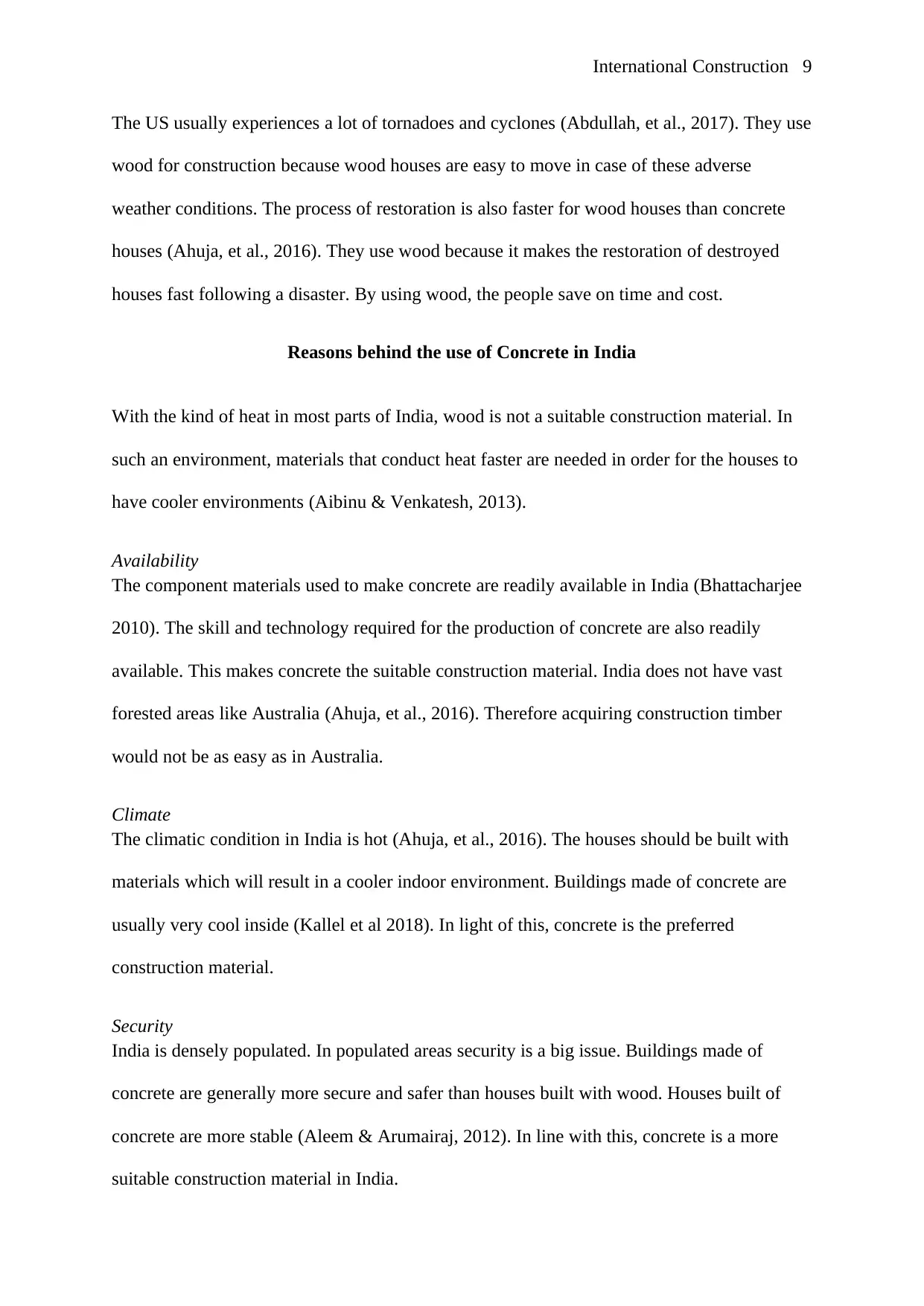
International Construction 9
The US usually experiences a lot of tornadoes and cyclones (Abdullah, et al., 2017). They use
wood for construction because wood houses are easy to move in case of these adverse
weather conditions. The process of restoration is also faster for wood houses than concrete
houses (Ahuja, et al., 2016). They use wood because it makes the restoration of destroyed
houses fast following a disaster. By using wood, the people save on time and cost.
Reasons behind the use of Concrete in India
With the kind of heat in most parts of India, wood is not a suitable construction material. In
such an environment, materials that conduct heat faster are needed in order for the houses to
have cooler environments (Aibinu & Venkatesh, 2013).
Availability
The component materials used to make concrete are readily available in India (Bhattacharjee
2010). The skill and technology required for the production of concrete are also readily
available. This makes concrete the suitable construction material. India does not have vast
forested areas like Australia (Ahuja, et al., 2016). Therefore acquiring construction timber
would not be as easy as in Australia.
Climate
The climatic condition in India is hot (Ahuja, et al., 2016). The houses should be built with
materials which will result in a cooler indoor environment. Buildings made of concrete are
usually very cool inside (Kallel et al 2018). In light of this, concrete is the preferred
construction material.
Security
India is densely populated. In populated areas security is a big issue. Buildings made of
concrete are generally more secure and safer than houses built with wood. Houses built of
concrete are more stable (Aleem & Arumairaj, 2012). In line with this, concrete is a more
suitable construction material in India.
The US usually experiences a lot of tornadoes and cyclones (Abdullah, et al., 2017). They use
wood for construction because wood houses are easy to move in case of these adverse
weather conditions. The process of restoration is also faster for wood houses than concrete
houses (Ahuja, et al., 2016). They use wood because it makes the restoration of destroyed
houses fast following a disaster. By using wood, the people save on time and cost.
Reasons behind the use of Concrete in India
With the kind of heat in most parts of India, wood is not a suitable construction material. In
such an environment, materials that conduct heat faster are needed in order for the houses to
have cooler environments (Aibinu & Venkatesh, 2013).
Availability
The component materials used to make concrete are readily available in India (Bhattacharjee
2010). The skill and technology required for the production of concrete are also readily
available. This makes concrete the suitable construction material. India does not have vast
forested areas like Australia (Ahuja, et al., 2016). Therefore acquiring construction timber
would not be as easy as in Australia.
Climate
The climatic condition in India is hot (Ahuja, et al., 2016). The houses should be built with
materials which will result in a cooler indoor environment. Buildings made of concrete are
usually very cool inside (Kallel et al 2018). In light of this, concrete is the preferred
construction material.
Security
India is densely populated. In populated areas security is a big issue. Buildings made of
concrete are generally more secure and safer than houses built with wood. Houses built of
concrete are more stable (Aleem & Arumairaj, 2012). In line with this, concrete is a more
suitable construction material in India.
⊘ This is a preview!⊘
Do you want full access?
Subscribe today to unlock all pages.

Trusted by 1+ million students worldwide
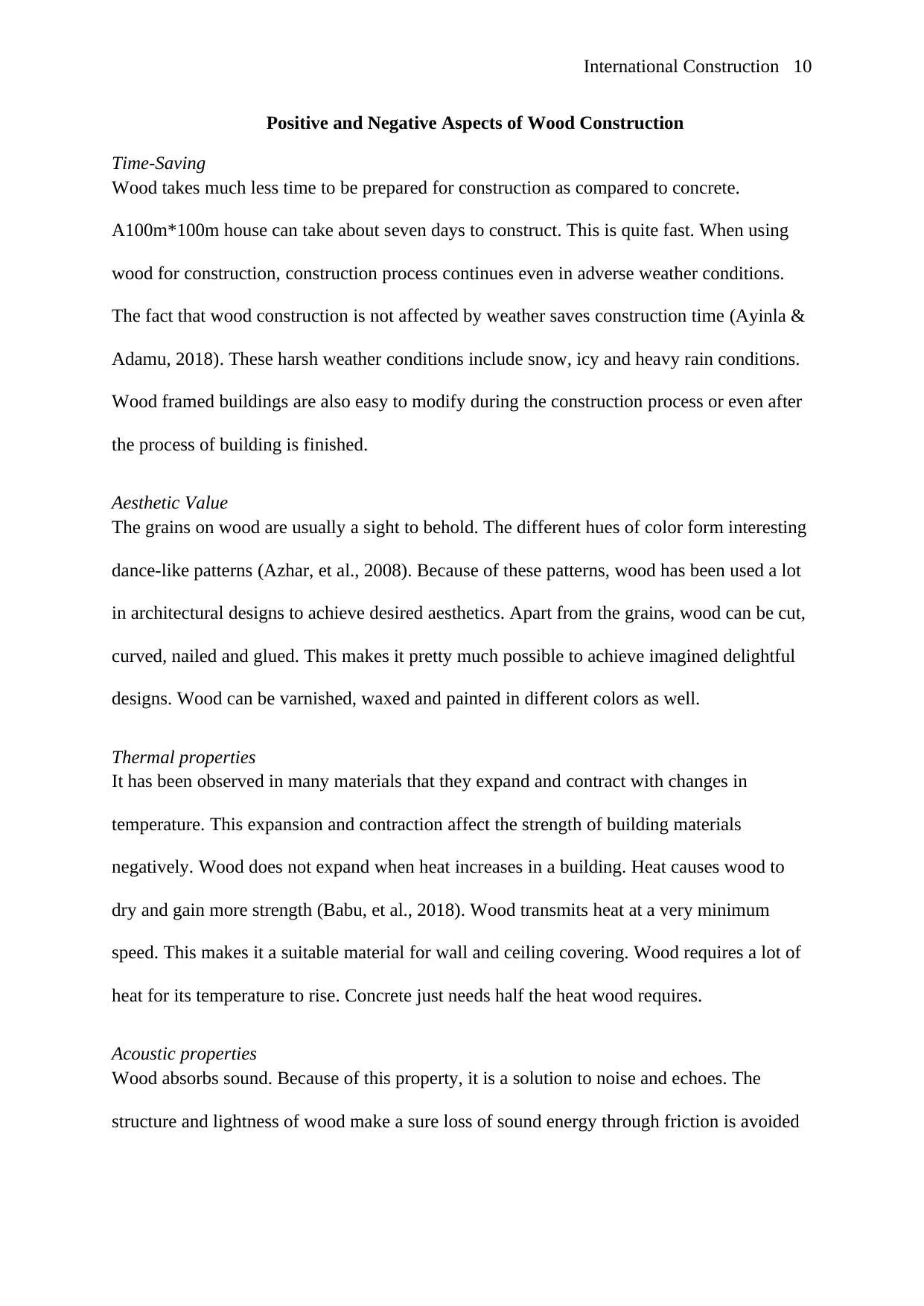
International Construction 10
Positive and Negative Aspects of Wood Construction
Time-Saving
Wood takes much less time to be prepared for construction as compared to concrete.
A100m*100m house can take about seven days to construct. This is quite fast. When using
wood for construction, construction process continues even in adverse weather conditions.
The fact that wood construction is not affected by weather saves construction time (Ayinla &
Adamu, 2018). These harsh weather conditions include snow, icy and heavy rain conditions.
Wood framed buildings are also easy to modify during the construction process or even after
the process of building is finished.
Aesthetic Value
The grains on wood are usually a sight to behold. The different hues of color form interesting
dance-like patterns (Azhar, et al., 2008). Because of these patterns, wood has been used a lot
in architectural designs to achieve desired aesthetics. Apart from the grains, wood can be cut,
curved, nailed and glued. This makes it pretty much possible to achieve imagined delightful
designs. Wood can be varnished, waxed and painted in different colors as well.
Thermal properties
It has been observed in many materials that they expand and contract with changes in
temperature. This expansion and contraction affect the strength of building materials
negatively. Wood does not expand when heat increases in a building. Heat causes wood to
dry and gain more strength (Babu, et al., 2018). Wood transmits heat at a very minimum
speed. This makes it a suitable material for wall and ceiling covering. Wood requires a lot of
heat for its temperature to rise. Concrete just needs half the heat wood requires.
Acoustic properties
Wood absorbs sound. Because of this property, it is a solution to noise and echoes. The
structure and lightness of wood make a sure loss of sound energy through friction is avoided
Positive and Negative Aspects of Wood Construction
Time-Saving
Wood takes much less time to be prepared for construction as compared to concrete.
A100m*100m house can take about seven days to construct. This is quite fast. When using
wood for construction, construction process continues even in adverse weather conditions.
The fact that wood construction is not affected by weather saves construction time (Ayinla &
Adamu, 2018). These harsh weather conditions include snow, icy and heavy rain conditions.
Wood framed buildings are also easy to modify during the construction process or even after
the process of building is finished.
Aesthetic Value
The grains on wood are usually a sight to behold. The different hues of color form interesting
dance-like patterns (Azhar, et al., 2008). Because of these patterns, wood has been used a lot
in architectural designs to achieve desired aesthetics. Apart from the grains, wood can be cut,
curved, nailed and glued. This makes it pretty much possible to achieve imagined delightful
designs. Wood can be varnished, waxed and painted in different colors as well.
Thermal properties
It has been observed in many materials that they expand and contract with changes in
temperature. This expansion and contraction affect the strength of building materials
negatively. Wood does not expand when heat increases in a building. Heat causes wood to
dry and gain more strength (Babu, et al., 2018). Wood transmits heat at a very minimum
speed. This makes it a suitable material for wall and ceiling covering. Wood requires a lot of
heat for its temperature to rise. Concrete just needs half the heat wood requires.
Acoustic properties
Wood absorbs sound. Because of this property, it is a solution to noise and echoes. The
structure and lightness of wood make a sure loss of sound energy through friction is avoided
Paraphrase This Document
Need a fresh take? Get an instant paraphrase of this document with our AI Paraphraser
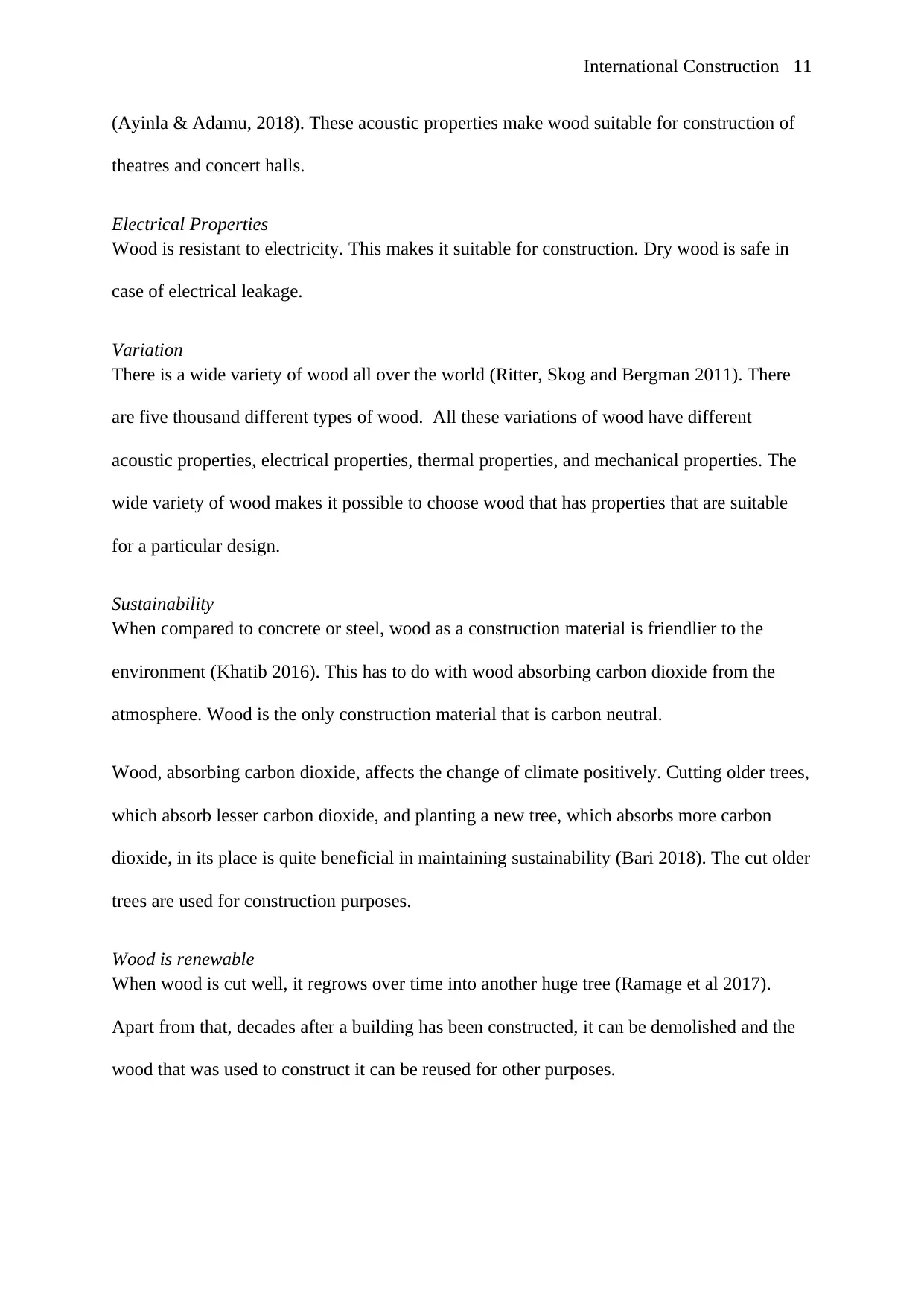
International Construction 11
(Ayinla & Adamu, 2018). These acoustic properties make wood suitable for construction of
theatres and concert halls.
Electrical Properties
Wood is resistant to electricity. This makes it suitable for construction. Dry wood is safe in
case of electrical leakage.
Variation
There is a wide variety of wood all over the world (Ritter, Skog and Bergman 2011). There
are five thousand different types of wood. All these variations of wood have different
acoustic properties, electrical properties, thermal properties, and mechanical properties. The
wide variety of wood makes it possible to choose wood that has properties that are suitable
for a particular design.
Sustainability
When compared to concrete or steel, wood as a construction material is friendlier to the
environment (Khatib 2016). This has to do with wood absorbing carbon dioxide from the
atmosphere. Wood is the only construction material that is carbon neutral.
Wood, absorbing carbon dioxide, affects the change of climate positively. Cutting older trees,
which absorb lesser carbon dioxide, and planting a new tree, which absorbs more carbon
dioxide, in its place is quite beneficial in maintaining sustainability (Bari 2018). The cut older
trees are used for construction purposes.
Wood is renewable
When wood is cut well, it regrows over time into another huge tree (Ramage et al 2017).
Apart from that, decades after a building has been constructed, it can be demolished and the
wood that was used to construct it can be reused for other purposes.
(Ayinla & Adamu, 2018). These acoustic properties make wood suitable for construction of
theatres and concert halls.
Electrical Properties
Wood is resistant to electricity. This makes it suitable for construction. Dry wood is safe in
case of electrical leakage.
Variation
There is a wide variety of wood all over the world (Ritter, Skog and Bergman 2011). There
are five thousand different types of wood. All these variations of wood have different
acoustic properties, electrical properties, thermal properties, and mechanical properties. The
wide variety of wood makes it possible to choose wood that has properties that are suitable
for a particular design.
Sustainability
When compared to concrete or steel, wood as a construction material is friendlier to the
environment (Khatib 2016). This has to do with wood absorbing carbon dioxide from the
atmosphere. Wood is the only construction material that is carbon neutral.
Wood, absorbing carbon dioxide, affects the change of climate positively. Cutting older trees,
which absorb lesser carbon dioxide, and planting a new tree, which absorbs more carbon
dioxide, in its place is quite beneficial in maintaining sustainability (Bari 2018). The cut older
trees are used for construction purposes.
Wood is renewable
When wood is cut well, it regrows over time into another huge tree (Ramage et al 2017).
Apart from that, decades after a building has been constructed, it can be demolished and the
wood that was used to construct it can be reused for other purposes.
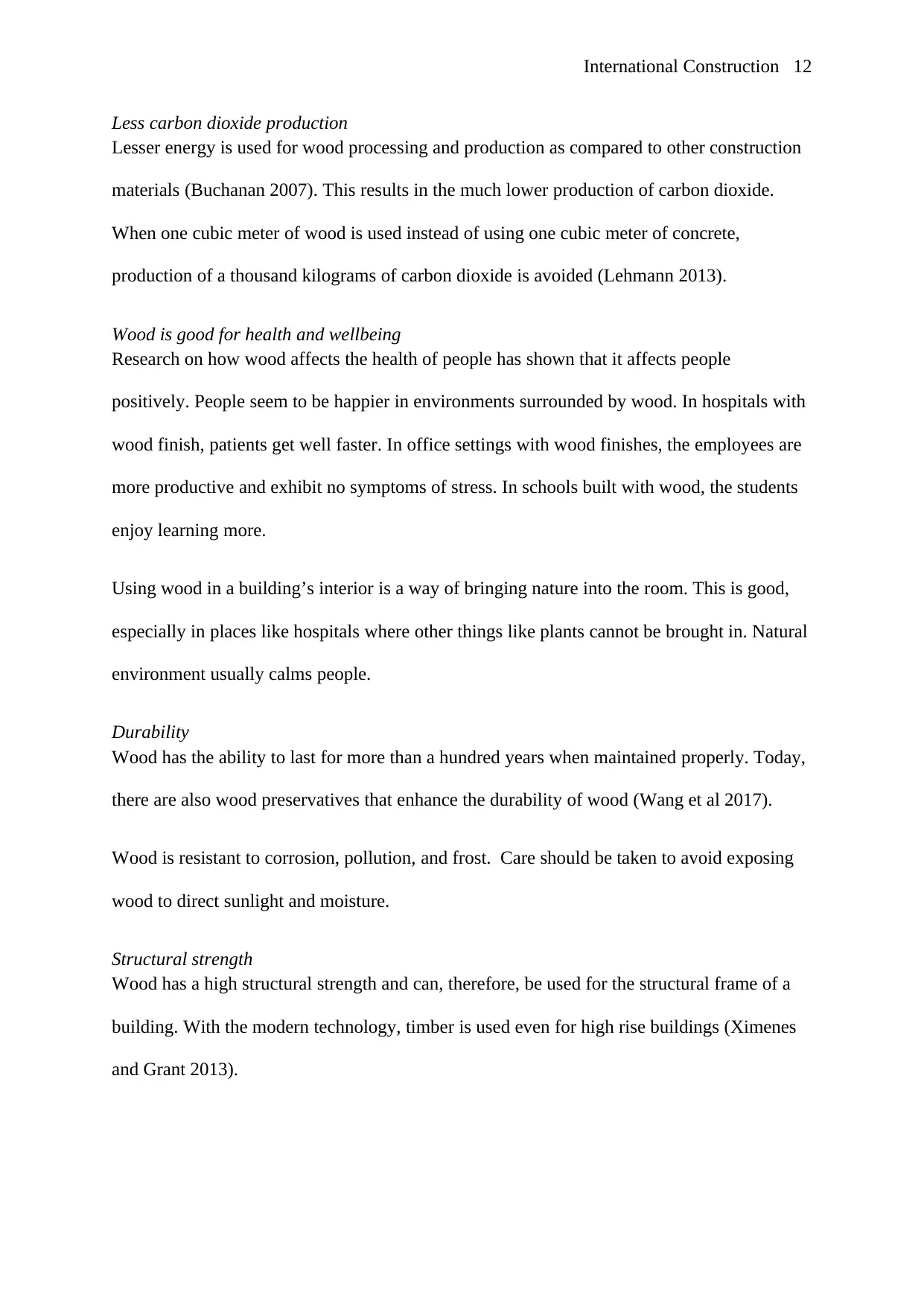
International Construction 12
Less carbon dioxide production
Lesser energy is used for wood processing and production as compared to other construction
materials (Buchanan 2007). This results in the much lower production of carbon dioxide.
When one cubic meter of wood is used instead of using one cubic meter of concrete,
production of a thousand kilograms of carbon dioxide is avoided (Lehmann 2013).
Wood is good for health and wellbeing
Research on how wood affects the health of people has shown that it affects people
positively. People seem to be happier in environments surrounded by wood. In hospitals with
wood finish, patients get well faster. In office settings with wood finishes, the employees are
more productive and exhibit no symptoms of stress. In schools built with wood, the students
enjoy learning more.
Using wood in a building’s interior is a way of bringing nature into the room. This is good,
especially in places like hospitals where other things like plants cannot be brought in. Natural
environment usually calms people.
Durability
Wood has the ability to last for more than a hundred years when maintained properly. Today,
there are also wood preservatives that enhance the durability of wood (Wang et al 2017).
Wood is resistant to corrosion, pollution, and frost. Care should be taken to avoid exposing
wood to direct sunlight and moisture.
Structural strength
Wood has a high structural strength and can, therefore, be used for the structural frame of a
building. With the modern technology, timber is used even for high rise buildings (Ximenes
and Grant 2013).
Less carbon dioxide production
Lesser energy is used for wood processing and production as compared to other construction
materials (Buchanan 2007). This results in the much lower production of carbon dioxide.
When one cubic meter of wood is used instead of using one cubic meter of concrete,
production of a thousand kilograms of carbon dioxide is avoided (Lehmann 2013).
Wood is good for health and wellbeing
Research on how wood affects the health of people has shown that it affects people
positively. People seem to be happier in environments surrounded by wood. In hospitals with
wood finish, patients get well faster. In office settings with wood finishes, the employees are
more productive and exhibit no symptoms of stress. In schools built with wood, the students
enjoy learning more.
Using wood in a building’s interior is a way of bringing nature into the room. This is good,
especially in places like hospitals where other things like plants cannot be brought in. Natural
environment usually calms people.
Durability
Wood has the ability to last for more than a hundred years when maintained properly. Today,
there are also wood preservatives that enhance the durability of wood (Wang et al 2017).
Wood is resistant to corrosion, pollution, and frost. Care should be taken to avoid exposing
wood to direct sunlight and moisture.
Structural strength
Wood has a high structural strength and can, therefore, be used for the structural frame of a
building. With the modern technology, timber is used even for high rise buildings (Ximenes
and Grant 2013).
⊘ This is a preview!⊘
Do you want full access?
Subscribe today to unlock all pages.

Trusted by 1+ million students worldwide
1 out of 29
Your All-in-One AI-Powered Toolkit for Academic Success.
+13062052269
info@desklib.com
Available 24*7 on WhatsApp / Email
![[object Object]](/_next/static/media/star-bottom.7253800d.svg)
Unlock your academic potential
Copyright © 2020–2025 A2Z Services. All Rights Reserved. Developed and managed by ZUCOL.